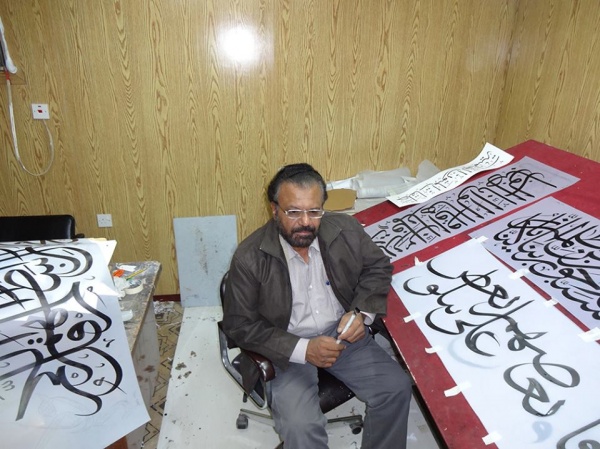Pakistani Calligrapher Of A Sacred Object
Shafiq Al Zaman has been the main calligrapher of the Prophet’s Mosque in Medina since winning the competition in 1991 in restoration of Arabic inscriptions which decorate the walls and arches of the second holiest site in Islam.
During the last twenty three years Pakistani Shafiq Al Zaman has been doing the job he loves: decoration of the walls and large domes of the Masjid al-Haram with calligraphic artful design in a fine style of Thuluth.
Al Zaman was awarded with the presidential award for Worthy Performance in Calligraphy. Al Zaman or as he likes to be called Hattat Al-Kharam (in Arabic: Calligrapher Of A Sacred Object) clearly remembers the day he arrived to Medina thanks to his love of Arabic calligraphy.
Al Zaman grew up in the city of Karachi in Pakistan. From childhood he began to take an interest in calligraphy. Besides borders and covers of newspapers and books he ornamented the walls of his own and neighboring houses with Arabic lettering.
Hattat Al-Kharam is proud of being an autodidact and not taking classes by any professional calligrapher. As Al Zaman says, at the very beginning he took Arabic calligraphy as a hobby only. In due course, learning through learning aids and practicing different calligraphy styles he improved his talent and achieved mastery in this art form. «I tried to take as a model the works by Hamid al-Amdi, the outstanding calligrapher of the Ottoman Empire, whom I consider my spiritual mentor», — Al Zaman says in an interview to the Arabic Asharq al-awsat edition.
The first time Al Zaman visited Saudi Arabia was a lot earlier. In the 1980s while visiting Karachi a Saudi trader liked the calligrapher’s works and he invited the master to work in his company at Riyadh. That is how Al Zaman came to Medina. Later on in 1991 another Saudi company Dallah announced a competition to choose the main calligrapher for the verses of the Quran restoration, which decorate the walls and arches of the second holiest site in Islam. As the result of the competition, Al Zaman was considered as the best one.
It is worth saying that in the Ottoman period each of the 177 Prophet’s Mosques were ornamented with the eleven-meter high Arabic lettering, executed by the outstanding Ottoman calligrapher Abdullah Zuhdi. However, due to corrosion part of the inscriptions faded in 250 years and there was need of restoration.
The refurbishment work is considered as a complex one because of a big difference between modern and the Ottoman methods of applying Quranic inscriptions on the arches. According to modern views, the Quranic ayat must be completely housed on the surface of one dome. However, this principle was not respected at the Ottoman period and one ayat was often divided and occupied more than one dome.
At present Al Zaman has completed 80% of his work on the Quranic inscription restorations. It is expected that it will take another 4-5 years to finish the work as each dome takes more than 3 months to work on. The calligrapher draws all the inscriptions in the Prophet’s Mosque by hand, not using computer technology.
«A calligrapher needs constant practice. I advise my students and those who really love Arabic calligraphy to examine works by great masters and continuously train to achieve perfection in this kind of a fine art», — Al Zaman shares his experience.
 Pakistani Calligrapher Of A Sacred Object
Pakistani Calligrapher Of A Sacred ObjectSource: www.islam-today.ru
Calligraphy is a remedy and mental gymnastics.



